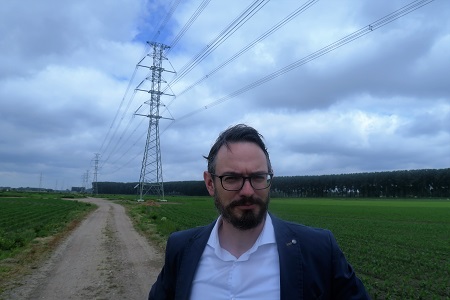Often in the countryside, but also near cities, we come across electric power lines with huge pylons, real eye-sores on the landscape. People sometimes wonder if it would be possible, with the help of modern technologies, to put these overhead power lines underground, well out of sight. Or, at least, use slimmer and less visually invasive pylons. We took these questions to an expert, Matthias Müller-Mienack, head of Research and Studies department at GridLab, Germany.

Matthias Müller-Mienack, head of Research and Studies department at GridLab, Germany
“Compared to the classic design of extra-high voltage overhead lines, there are now much more compact overhead lines available with smaller shapes and requiring less width of route,” he said. “A major component is the application of insulated cross-arms, which allow the wires to be directly fitted to the tower. This reduces both the tower height and the oscillations of the wires in the wind.”
The new insulated cross-arms technology has been applied and tested under the European project Best Paths. As part of this, new test methods have been prepared to verify the long-term electrical performance, since there are no standards or test methods available yet.
“The erection and operation procedures for insulated cross-arms have been tested for the new Belgian STEVIN line project,” Müller-Mienack continued. The 47 km-long, 380-kV link between Zeebrugge and Zomergem in Flanders, will transport energy generated by the new offshore wind farms to the mainland, encouraging green energy projects in the region. The compact design will meet three objectives: minimum visual effects on the landscape, low electro-magnetic field and noise, and better transport capacity, he added.
For many years, researchers have also been envisaging the solution of partially burying power lines, complementing overhead lines where their deployment is restricted by public concerns or environmental limitations.
Müller-Mienack said that cross-linked polyethylene (XLPE) cables are excellent for using underground because of their insulation properties. They have excellent physical and electrical properties, and life expectancy. “These kinds of cables can be directly buried in the ground or installed in tunnels. In urban areas especially, this solution might be the only possibility to set up transmission lines,” he explained.
“There is a restriction on the use of land over buried cables: no deeply rooted trees may be planted within the corridor. Apart from that, there are no limitations to farming. Furthermore, as the underground XLPE cables are shielded, no electric field exposure can be detected above ground.”
“Regarding operational expenditure, an XLPE cable system is nearly maintenance free. Finally, the failure rate (only 0.0307 failures per year, according to a 2009 Cigré report) is significantly lower compared to extra-high voltage overhead lines.”
However, XLPE cables and underground cables in general require digging trenches and this may be complicated by other utility service lines such as water pipes, oil and gas pipelines, sewers. Other complications may arise due to rocks, loose soil and water along the routes.
“There are disadvantages with XLPE cables compared to overhead lines,” Müller-Mienack said. “In onshore applications, for logistical reasons XLPE cables can only be delivered in lengths of up to 1,150 metres per phase conductor, thus special joint bays need to be erected typically every 700 to 1000 metres. Also, civil works required to erect extra-high voltage cable routes may have a considerable impact on the environment. Access tracks and haulage roads to the site are required for the heavy trenching machinery, cable drums, backfill material and equivalent soil. However, to a large extent they are removed after the works have been completed.”
Müller-Mienack added that for underground cables there are also problems from an economic point of view: “Considering the same transmission capacity, the investment costs for extra-high voltage XLPE cable are typically 5 to 10 times higher than overhead line solutions. Moreover, the significantly longer repair times for XLPE cable routes need to be mentioned.”
“According to the Cigré report, in the period 2000 to 2005 more than one third of the cable faults in extra-high voltage cable systems were repaired within one week and more than 75% within one month. Although this statistic doesn’t consider outage times under 1 day or over 6 months, it implies that up to 25 % of recorded extra-high voltage cable faults required repair times longer than one month.”
In conclusion, there are advantages and disadvantages on both sides. Overhead lines are easier to repair, set up and maintain and they are cheaper. However, they are visually polluting and can suffer from vandalism, strong winds and lightning, and they produce electromagnetic fields. On the other hand, underground lines are more expensive, but less invasive on the landscape. Researchers believe the solution is to combine both types of cables, according to the area.
youris.com provides its content to all media free of charge. We would appreciate if you could acknowledge youris.com as the source of the content.